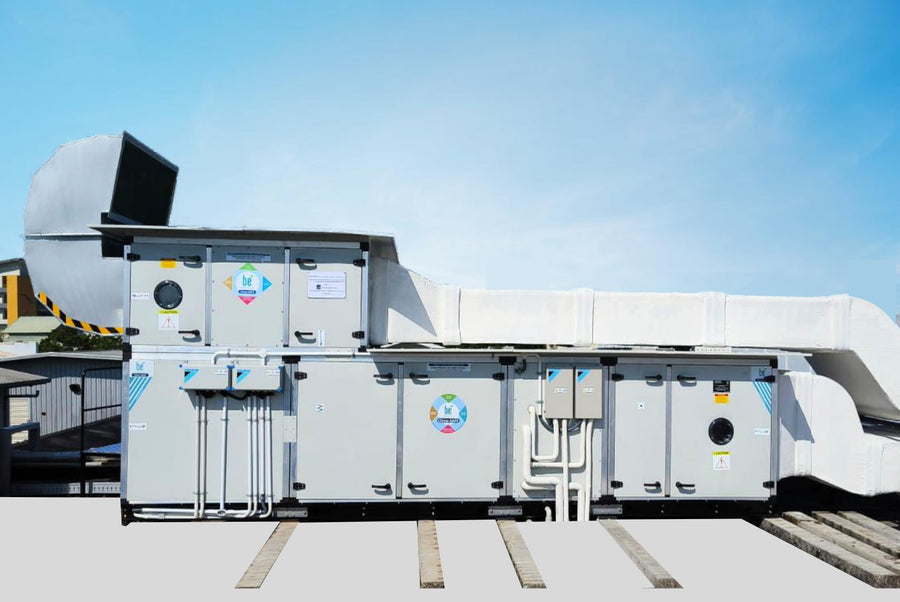Importance Of Indoor Air Quality For Employees

Importance Of Indoor Air Quality For Employees
There is no doubt that our built environment has a profound impact on our health, well-being, happiness and productivity.It can shape our habits and choices, regulate our sleep-wake cycle, drive us toward healthy and unhealthy choices, and passively influence our health through the quality of our surroundings.
According to a study by WELL, we spend 90% of our time indoors, hence it is imperative for us to understand the impact of indoor air on our health and wellness as occupants. While companies focus on various diet and wellness programs, they need to start talking about the environment of the building itself. Developments that look at features related to wellness can help create a built environment that improves the nutrition, fitness, mood, sleep patterns and performance of its residents. USGBC and IGBC have their own wellness related standards. The “WELL” Standard for USGBC and the “Health and Well Being Standard” of IGBC.
Our built environment shapes our personality, the choices we make, the habits we have, our sleep cycle, thus, driving us passively towards a healthier life. Indoor Air Quality (IAQ) is a large part of the overall indoor environment that has a direct impact on occupants. Better air quality means fewer pollutants in the air and more oxygen to breathe. And with the improved flow of oxygen to the brain, our cognitive performance gets better, hence resulting in an increase in productivity at work.
Health and Wellness is one of the largest growing markets, directly impacted by the rising demand of consumers. In the next two years, the owners, designers and builders are expecting health to have a higher influence on design and construction decisions of owners. Wellness Standards provide the opportunity to design and build with a human-centred approach, ultimately supporting the industry in addressing human health.
A wellness certified project adds value to the well being and health of its building occupants. It is helpful in generating a meaningful return on investment thereby increasing savings and productivity. People should eventually be the centre of all the decisions for design and construction, as it will not only add value to the real estate assets but also generate savings for the business. As personnel costs significantly outweigh the design and construction costs as well as the maintenance and operations costs, we should focus on addressing occupants health channels for a meaningful return on investment. About 90% of the employees admitted that their attitude about work is adversely affected by the quality of their workplace environment.Physical workplace is one of the top three factors affecting performance and job satisfaction.
Wellness factors empower the creation of healthy environments for people to live, work and play, enhancing occupant health and quality of life globally.These factors can be broadly categorised in seven categories, or Concepts, relevant to occupant health and well-being in the built environment: air, water, nourishment, light, fitness, comfort and mind. The Standards for Air promote clean air through reducing or minimizing the sources of indoor air pollution, requiring optimal indoor air quality to support the health &well-being of building occupants. Strategies include removal of airborne contaminants, prevention and purification.
A recent study by teams from Harvard and Syracuse Universities on indoor air quality suggests that employees in green environmental conditions performed 61% better on cognitive tasks than in standard office conditions. And if one doubles the ventilation, cognitive performance can be increased by more than 100%.
We can achieve the highest level of indoor air quality by taking care of the most common and deadliest pollutants.
PM2.5: They are these tiny and fine particles which tend to stay longer in the air than the heavy particles. This, therefore, increases the chances of humans or animals inhaling them into their bodies. They are able to penetrate deep into our lungs after bypassing the throat and nose, which may eventually result in them entering our circulatory system. They are known to worsen chronic diseases such as asthma, heart attack, bronchitis etc, infact exposure to these fine particles could result in premature deaths from heart and lung diseases.
CO2: At room temperature, carbon dioxide is an odorless, colorless, non-flammable gas. When CO2 hits 1000ppm in a room, workers feel slightly fatigued with common complaints of headaches and that result in low productivity. CO2 in the range of 2,000-5,000 ppm can result in poor concentration, loss of attention, increased heart rate and slight nausea.
TVOCs: They include a variety of chemical substances, which can lead to fatal health illnesses. Typically, VOC concentrations are up to 10 times higher inside as compared to the outdoors. These are typically even higher after new constructions and a “flush out” phase is required before the occupants can move in. With long term monitoring, RESET Air (Standard for Air Quality for Indoor spaces) provides an alternative to standard industry practice in which spaces are flushed out, tested, certified, and unknowingly left to climb back up to hazardous levels.
To lead by example, our own building Paharpur Business Centre has been rated as one of the healthiest buildings of Delhi by the Central Pollution Control Board (CPCB), Govt of India and also been tested to have very high air quality by Lawrence Berkeley National Labs (LBNL), California. We grow our own fresh airTM in the 50,000 square feet space. We are able to curate the best quality of air possible using a combination of sophisticated mechanical filtration as well as indoor plants. The result is air so fresh – it feels like mountain air.







